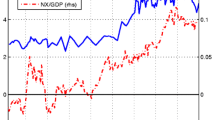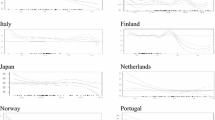Abstract
This paper analyses a model of non-linear exchange rate adjustment that extends the literature by allowing asymmetric responses to over- and under-valuations. Applying the model to Greece and Turkey, we find that adjustment is asymmetric and that exchange rates depend on the sign as well as the magnitude of deviations, being more responsive to over-valuations than undervaluations. Our findings support and extend the argument that non-linear models of exchange rate adjustment can help to overcome anomalies in exchange rate behaviour. They also suggest that exchange rate adjustment is non-linear in economies where fundamentals models work well.
Similar content being viewed by others
References
Alogoskoufis, G. 1995. “The Two Faces of Janus: Institutions, Policy Regimes and Macroeconomic Performance in Greece.”Economic Policy 20: pp. 149–192.
Bhagwati, J. 1984. “Why are Services Cheaper in Poor Countries?”Economic Journal 94: 279–286.
Baum, C.F., J.T. Barkoulas and M. Caglayan. 2001. “Non-Linear Adjustment to Purchasing Power Parity in the Post-Bretton Woods Era.”Journal of International Money and Finance 20: 379–399.
Clarida, R., L. Sarno, M.P. Taylor and G. Valente. 2002. “The Out-of-Sample Success of Term Structure Models as Exchange Rate Predictors: A Step Beyond.” Centre for Economic Policy Research. Discussion Paper No 3281.
Coleman, A.M.G. 1995. “Arbitrage, Storage and the Law of One Price: New Theory for the Time Series Analysis of an Old Problem.” Discussion Paper. Department of Economics, Princeton University.
Cukierman, A. and S. Gerlach. 2003. “The Inflation Bias Revisited: Theory and Some International Evidence.” Centre for Economic Policy Research. Discussion Paper No 3761.
Dickey, D.A. and W.A. Fuller. 1979. “Distribution of the Estimators for Autoregressive Time Series with a Unit Root.”Journal of American Statistical Association 74: 427–431.
Dixit, A.K. 1989. “Hysterisis, Import Penetration and Exchange Rate Pass-Through.”Quarterly Journal of Economics 104: 205–228.
Dumas, B. 1992. “Dynamic Equilibrium and the Real Exchange Rate in Spatially Separated World.”Review of Financial Studies 5: 153–180.
Enders, W. and S. Dibooglu. 2001. “Long Run Purchasing Power Parity with Asymmetric Adjustment.”Southern Economic Journal 68: 433–445.
Enders, W. and B. Falk. 1998. “Threshold-Autoregressive, Median Unbiased, and Cointegration Tests of Purchasing Power Parity.”International Journal of Forecasting 14: 171–186.
Froot, K.A. and K. Rogoff. 1995. “Perspectives on Purchasing Power Parity and Long-Run Real Exchange Rates.” InThe Handbook on International Economics Vol. 3, edited by in E. Grossman and K. Rogoff. Amsterdam; North Holland. 1647–1688.
Granger, C.W.J. and T. Teräsvirta. 1993.Modelling Non-linear Economic Relationships. Oxford: Oxford University Press.
Johansen, S. 1988. “Statistical Analysis of Cointegration Vectors.”Journal of Economic Dynamics and Control 12: 231–254.
Karfakis, C. and D. Moschos. 1989. “Testing for Long-Run Purchasing Power Parity: A Time-Series Analysis for the Greek Drachma.”Economics Letters 30: 245–248.
Kibritcioglu, A., L. Rittenberg, and F. Selcuk (eds.). 2000.Inflation and Disinflation in Turkey. Aldershot. England: Ashgate.
Kravis, I.B. and R.E. Lipsey. 1983. “Towards an Explanation of National Price Levels.”Princeton Studies in International Finance 52, Princeton N.J.: International Finance Section, Department of Economics, Princeton University.
Krugman, P. 1990. “Equilibrium Exchange Rates.” InInternational Monetary Policy Coordination and Exchange Rate Fluctuations, edited by W.H. Branson, J.A. Frenkel and M. Goldstein. Chicago: University of Chicago Press, pp. 159–187.
Luukkonen, R., P. Saikkonnen and T. Teräsvirta. 1988. “Testing Linearity Against Smooth Transition Autoregressive Models.”Biometrika 75: 491–499.
MacKinnon, J. 1991. “Critical Values for Co-integration Tests.” InLong-Run Economic Relationships, edited by R.F. Engle and C.W.J. Granger. Oxford: Oxford University Press. 267–276.
Maddala, G.S. and I.M. Kim. 1998.Unit Roots, Cointegration and Structural Change. Cambridge: Cambridge University Press.
McNown, R. and M.S. Wallace. 1989. “National Price Levels, Purchasing Power Parity and Cointegration: A Test for Four High Inflation Economies.”Journal of International Money and Finance 8: 533–546.
Meese, R. and K. Rogoff. 1983. “Empirical Exchange Rate Models of the Seventies: Do They Fit Out the Sample?”Journal of International Economics 14: 3–24.
Michael, P., A.R. Nobay and D.A. Peel. 1997. “Transaction Costs for Non-linear Adjustment in Real Exchange Rates: An Empirical Investigation.”The Journal of Political Economy 105: 862–879.
Mourmouras, I.A. and M.G. Arghyrou. 2000.Monetary Policy at the European Periphery, The European and Transatlantic Studies Series. Berlin-New York: Spring-Verlag.
Obstfeld, M. and A. Taylor. 1997. “Non-Linear Aspects of Goods Market Arbitrage and Adjustment: Hecksher’s Commodity Price Points Revisited.”Journal of Japanese and International Economies 11: 441–479.
O’Connell, P.G.J. 1998. “Market Frictions and Real Exchange Rates.”Journal of International Money and Finance 17: 71–95.
Organisation for Economic Cooperation and Development (OECD). 2002.Economic Survey: Turkey 2002. Paris.
Perron, P. 1988. “Trends and Random Walks in Macroeconomic Time Series: Further Evidence from a New Approach.”Journal of Economic Dynamics and Control 12: 297–332.
Phillips, P.C.B. and P. Perron. 1988. “Testing for a Unit Root in Time Series Regression.”Biometrika 75: 335–346.
Rogoff, K. 1992. “Traded Goods Consumption Smoothing and the Random Walk Behavior of the Real Exchange Rate.”Bank of Japan Monetary and Economic Studies 10: 1–29.
Rogoff, K. 1996. “The Purchasing Power Parity Puzzle.”Journal of Economic Literature 34: 647–668.
Rogoff, K. 1999. “Monetary Models of Dollar/Yen/Euro Nominal Exchange Rates: Dead or Undead?”The Economic Journal 109: F655-F659.
Saikonnen, P. and R. Luukkonen. 1988. “Lagrange Multiplier Tests for Testing Non-Linearities in Time Series Models.”Scandinavian Journal of Statistics 15: 55–68.
Sercu, P., R. Uppal and C. van Hulle. 1995. “The Exchange Rate in the Presence of Transaction Costs: Implications for Tests of Purchasing Power Parity.”Journal of Finance 50: 1309–1319.
Shleifer, A. and R.W. Vishny. 1997. “The Limits of Arbitrage.”Journal of Finance 52: 35–55.
Taylor, M.P. (1988), “An Empirical Examination of Long-Run Purchasing Power Parity Using Cointegration Techniques.”Applied Economics 20: 1369–1382.
Taylor, M.P. 1995. “The Economics of Exchange Rates.”Journal of Economic Literature 33: 13–47.
Taylor, M.P. and D.A. Peel. 2000. “Non-Linear Adjustment, Long-Run Equilibrium and Exchange Rate Fundamentals.”Journal of International Money and Finance 19: 33–54.
Taylor, M.P. and L. Sarno. 1998. “The Behavior of Real Exchange Rates During the Post-Bretton Woods Period.”Journal of International Economics 46: 281–312.
Taylor, M.P., D.A. Peel and L. Sarno. 2001. “Non-Linear Mean-Reversion in Real Exchange Rates: Toward a Solution to the Purchasing Power Parity Puzzles.”International Economic Review 42: 1015–1042.
Teräsvirta, T. 1994. “Specification, Estimation and Evaluation of Smooth Transition Autoregressive Models.”Journal of the American Statistical Association 89: 208–218.
Tong, H. 1990.Non-linear Time Series: A Dynamical System Approach. Oxford: Clarendon Press.
Uppal, R. 1993. “A General Equilibrium Model of International Portfolio Choice.”Journal of Finance 48: 529–553.
van Dijk, D., T. Teräsvirta and P.H. Franses. 2002. “Smooth Transition Autoregressive Models —A Survey of Recent Developments.”Econometric Reviews 21: 1–47.
Author information
Authors and Affiliations
Corresponding author
Additional information
We thank Costas Milas for some useful conversations and comments.
Rights and permissions
About this article
Cite this article
Arghyrou, M.G., Boinet, V. & Martin, C. Non-linear and non-symmetric exchange-rate adjustment: Evidence from medium- and high-inflation countries. J Econ Finan 30, 38–56 (2006). https://doi.org/10.1007/BF02834274
Issue Date:
DOI: https://doi.org/10.1007/BF02834274




